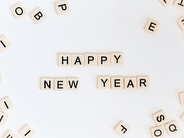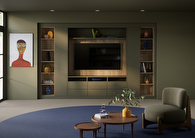
How to organise and declutter your home for the New Year
Set a precedent for the new year by decluttering your home using tips from our experts.


A good night’s sleep can make a world of difference day-to-day, but the amount of sleep needed can vary from person to person.
The NHS recommends the ideal sleep duration for an adult is between 7-9 hours each day, however according to a recent YouGov survey, over a third (35%) of Brits are getting less than 7 hours sleep per night.
Nearly half (49%) of people thought they weren’t getting enough sleep, and a worrying 20,000 people are Googling the phrase ‘I can’t sleep’ every month.
While poor sleep quality can be due to several factors such as stress, diet, and exercise, we believe that your bedroom décor can play a major role in ensuring you get the perfect night's sleep.
With this in mind, we have created a bedroom design that we believe is the ideal space to encourage a restful night of good quality sleep, as well as a design showing you what to avoid.
By combining our interiors expertise with insight from external sleep experts we have created the perfect bedroom design for sleep; that shows all the key features we need to switch off and enjoy some much-needed Zs.
Essentially, an optimal bedroom for sleep includes:
To help define what distinguishes a sleep-ready room from a no-sleep space, we have also created a room design that shows all the things that could be making rest and relaxation more of a challenge. These include:
Ultimately, sleep needs to be the focus of any bedroom. Sleep Expert at Trouble Sleeping, Dr Lindsay Browning reiterated this stating: “Our sleeping environment can have a significant impact on how well we sleep. In an ideal world, our bedroom should be a sanctuary for sleep”. Nevertheless, electronics and exercise equipment have become mainstays in many homes across the UK.
While sleep experts say that a bedroom should ideally have no electronics in the room, we know this isn’t always possible, so the recommendation is to minimise electronics as much as you can.
TVs, laptops, and tablets can all be a distraction when trying to get some shut eye, with the light they emit causing issues when trying to drift off.
BIID and SBID registered interior designer, Dee Gibson explained the importance of reducing technology usage in the bedroom, saying: “Minimising electromagnetic waves is important. Put your phone onto sleep mode and get an analogue alarm clock. Avoid putting TVs in bedrooms too. Many people want USB plugs these days and ask for them in bedrooms but try to avoid using these devices before bedtime!”
While Lisa Slack, Head of Product at Thomas Sanderson explained the need to avoid your phone before bed: "Phones emit blue light which can trick your brain into thinking it’s daytime, despite being dark outside.
Blue light also suppresses levels of melatonin in the body, a natural hormone which is responsible for controlling our sleep cycle.
Lower levels of melatonin have been linked to insomnia and irritability, so staying away from your phone before bed is essential for a good night’s sleep."
Can the colour of the bedroom impact your sleep? Colours can affect your mood and emotions which can either make you go to bed angry or ideally calm and happy.
Our survey revealed the most calming wall colour was White (21%) followed by duck egg (20%), pale grey (20%), beige (16%) and sage green (14%).
Dark and bright colours were voted the least calm wall colours by respondents, as only 2% voted dark purple and dark grey to be calm, whilst hot pink (3%) and red (5%) weren’t popular colours when looking to create a zen home.
Yvonne Keal, Senior Product Manager at Hilarys explains why the colour of your bedroom is important: “You may be questioning why you’re having trouble sleeping at night and the answer may be staring you in the face… the colour of your bedroom walls! In order to get a good night's sleep, you’ll want to avoid any bright and intense colours in your bedroom and focus on soft, dusty tones to promote relaxation and help you doze off.”
If your room needs a touch up or you want to change the wall colour, opt for matte paint rather than gloss, as it offers a less reflective look, keeping colours softer for more effective sleep. Pistachio and glacier blue are two recommended options from the experts.
Having lots of clutter around does you no favours when it comes to bedtime and could be the cause of some sleep issues. An organised and clutter free room is typically considered necessary for creating a peaceful environment to maximise sleep.
Sleep Expert, Dr Lindsay Browning said: “A messy bedroom can be bad for sleep as you may be thinking about how you should be tidying up, instead of feeling relaxed and falling asleep.”
In our design for the perfect room for sleep, you can see there is no clutter on the bedside tables or floor, while all clothes are in the fitted wardrobes. Strategically placed bins and laundry baskets prevent dirty clothes and rubbish being scattered across the room too.
Interior designer, Dee Gibson added: “Bedside tables need to be big enough to hold lamps, books, and glasses, and have storage to hide away pills, notepads, hand creams and all the other clutter we accumulate. They say tidy house, tidy mind - it fools your brain into winding down.”
In the warm summer months - which offer long, light days - it is often really beneficial to have blackout blinds that stop the light from sneaking in and preventing you getting to sleep or waking you up early in the morning.
Keeping your blackout blind shut during hot days can stop the sun warming up the room too. This is beneficial as the temperature of your room should be cool when sleeping and as we all know, getting to sleep in a warm room can be a nightmare.
Lighting is imperative to the room too, with Marketa Rypacek, Managing Director at Industville Ltd advising “Lighting is one of the most important aspects to think about in any space, as the right light can change the dynamics of a room to create the perfect ambience. There are three main types of lighting: ambient, task and accent, each adding a different layer to the interior. The correct blend of layered lighting is vital to get right as it influences human moods and emotions.
The number one consideration for lighting any space, no matter what the size, scale or budget has to be a dimmer switch. Dimmer switches are a quick and cost-effective way of offering multiple lighting levels in a space, allowing the homeowner to set the tone and change the atmosphere of a room instantly.
This is integral for a bedroom setting as part of our natural human circadian rhythm, studies have shown that dimmed warm light helps us wind down for the day and get ready for sleep.”
Noise is a sleep deterrent for the majority of people, so what can we do to reduce it? Believe it or not but adding a rug can go a long way to solving this issue, as they can help absorb noise while also adding a nice addition to the room.
Calming scents can help when trying to relieve stress and anxiety when going to sleep too. Scents such as Cedar, Lavender and Chamomile can be added to the room through candles, incense holders and diffusers – but don’t forget to blow out candles before you nod off!
Lisa Slack, recommends using essential oils: "To really maximize a good night’s sleep, use essential oils to provoke sleepy vibes. If you don’t have a diffuser, add a few drops of lavender oil on to a tissue and inhale the scent before bedtime. This can help calm the mind and relax in preparation for sleep."
Symmetry provides your room with balance, and this helps us to feel calmer. Creating symmetry can easily be done through our bedside tables, which can sit on either side of our bed.
The bed should always be the focal point of the bedroom too, after all, it is for sleeping! Furthermore, a good night’s sleep requires a good quality mattress and clean bedding.
Comfort is crucial, and bed height should be proportionate to your height and appropriate for the room size (e.g. taller ceilings can have a taller bedframe). Getting out of bed should be easy and not put pressure on the body.
Avoid putting the bed in front of a doorway too, and make sure you can navigate your way around the bed freely.
All these expert tips and perfect bedroom visuals will help you adjust your room décor to ensure you can get the optimal sleep needed.
Here at Hammonds, we can make life easier through sliding wardrobes in neutral colours to make sure your bedroom is not cluttered and the colours match those required for a good night’s sleep.
Sources:

Set a precedent for the new year by decluttering your home using tips from our experts.

Inspired by nature and rooted in calm, grounding tones, the earthy living room trend is all about bringing the warmth and serenity of the outdoors into your living space.

Living rooms can be hard to get right. They're often busy family rooms where children play, dogs sleep and the grown-ups take a moment with a cup of tea.
Whether you have an exact vision in tow, or are just at the beginning stage of your home renovation, we have heaps of inspiration for you to get stuck into.
Find a wealth of design tips, trends and inspiration in the pages of our brochure, magazine and on our blog. Our experts are always ready to help you create dream home, pop in store or book your free design visit for experts to help on bringing your vision to life.